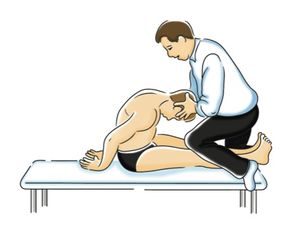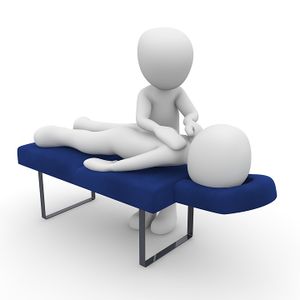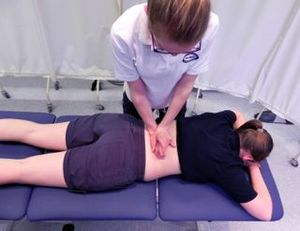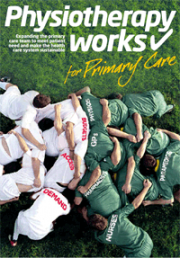Manual Therapy
Original Editor - Finn Gerstell
Top Contributors - Finn Gerstell, Jess Bell, Admin, Kim Jackson, Lucinda hampton, Dana Tew, Samuel Winter, Carin Hunter, Rachael Lowe, Elaine Lonnemann, Mande Jooste, David Drinkard, Hanz Tao, Matt Huey, WikiSysop, Shaimaa Eldib, Rucha Gadgil, Scott Buxton and Kai A. Sigel
Description[edit | edit source]
Manual therapy has a long history within the profession of physical therapy and physical therapists have greatly contributed to the current diversity in manual therapy approaches and techniques. Mechanical explanations were historically used to explain the mechanisms by which manual therapy interventions worked. Contemporary research reveals intricate neurophysiologic mechanisms are also at play and the beneficial psychological effects of providing hands-on examination and intervention have been substantiated.[1]
The International Federation of Orthopaedic Manipulative Physical Therapists (IFOMPT) defines orthopaedic manual physical therapy as: "a specialised area of physiotherapy/Physical Therapy for the management of NMS conditions, based on clinical reasoning, using highly specific treatment approaches including manual techniques and therapeutic exercises. Orthopaedic Manual Therapy also encompasses, and is driven by, the available scientific and clinical evidence and the biopsychosocial framework of each individual patient."
According to the American Academy of Orthopaedic Manual Physical Therapists (AAOMPT) Description of Advanced Specialty Practice (DASP) (2018), orthopaedic manual physical therapy (OMPT) is defined as: “an advanced specialty area of physical therapy practice that is based on manual examination and treatment techniques integrated with exercise, patient education, and other physical therapy modalities to address pain, loss of function, and wellness.
Early, consistent, and skillful manual physical therapy, combined with exercise and patient education, is central to the OMPT therapist’s practice. Advanced examination, communication, and decision-making skills that are built on the foundations of professional and scientific education facilitate the provision of effective and efficient care. Practitioners of OMPT provide patient management, consult with other health care providers regarding simple as well as complex neuromusculoskeletal (NMS) conditions, and provide recommendations and interventions in the area of health and wellness."
Three Paradigms for Manual Therapy Therapeutic Effects[edit | edit source]
- Physiological: positive placebo response
- Biomechanical and Physical: facilitates repair and tissue modelling
- Psychological: pain relief via- stimulates gating mechanism; muscle inhibition; reduction of nocioceptive activity; reduced intraarticular or periarticular pressure[2]
Manual Therapy Frameworks[edit | edit source]
Cyriax
System of Prescription: Whether the problem is caused by a joint, a muscle or a nerve
Area: Spine and peripheral joints:
Treatment Methods: Deep transverse friction and traction or manipulation techniques:
Lewit Manual therapy
System of Prescription: Viewed as a chain of interrelated pathologies
Area: Spine and peripheral joints
Treatment Methods: Mobilizing, manipulating and actively exercising
Kaltenborn-Evjenth manual therapy
System of Prescription: Specialized manual tests to determine whether the source of pain is in tense muscle, an irritated nerve or a degenerated joint:
Area: Spine and joint
Treatment Methods: Ttransverse massage, functional massage, post-isometric relaxation, joint mobilization, joint manipulation and neuromobilization
Maitland manual therapy
System of Prescription: Joints, muscles and nervous tissue in both the spine and peripheral joints
Area: Most important thing is not to discover the immediate cause of the dysfunction, but to observe the symptoms and apply the best therapeutic technique: Also looks to solve a given functional problem by eliminating pain sensations, restoring proper mobility in the joint and normalising muscle tension
Treatment Methods: Rhythmic, passive, painless movements introduced into the tissue (mobilizations) and rapid movements (manipulations)
Mckenzie manual therapy
System of Prescription: Therapy to heal the spine through active patient movements
Area: Spine
Treatment Methods: The therapist and the patient are looking for this direction of movement that brings a relevant improvement after a few repetition
Mulligan manual therapy
System of Prescription: Mulligan’s therapy is based on active patient movements combined with passive correction of the joint position held by a physiotherapist
Area: Spine, and limbs, pirimarily to address pathologies affecting the periphery
Treatment Methods:
- Painless, functional loading of the articular surfaces with the force of gravity
- Combining passive movement in the plane of the articular surfaces with active movement
- Applying overpressure at the end of the painless movement range
- Applying an appropriate number of repetitions
Techniques Include[edit | edit source]
- Traction
- Massage
- Trigger Point Therapy
- Active Release Techniques: A practitioner determines where adhesions are through touch, the practitioner then couples a patient's active movement with his/her touch. [3]
- Assisted Active Range of Motion (AAROM)
- Passive Range of Motion
- Lymph Drainage
- Stretches (muscle, neural tissue, joints, fascia)
- Instrument Assisted Soft Tissue Mobilization
- Joint Manipulation: A passive, high velocity, low amplitude thrust applied to a joint complex within its anatomical limit* with the intent to restore optimal motion, function, and/ or to reduce pain.[4]
- Joint Mobilisation: A manual therapy technique comprising a continuum of skilled passive movements to the joint complex that are applied at varying speeds and amplitudes, that may include a small-amplitude/ high-velocity therapeutic movement (manipulation) with the intent to restore optimal motion, function, and/ or to reduce pain.[4]
NB The terms "Thrust Manipulation" and "Non-Thrust Manipulation" have been used in the literature. "Thrust Manipulation" is used to describe interventions described as Manipulation by IFOMPT, and "Non-Thrust Manipulation" would be synonymous with the term Mobilization as proposed by IFOMPT.
- When, and only when movement is painless, applying overpressure at the end of the painless movement
Guide to Grading of Mobilisations/Manipulations[edit | edit source]
Maitland Joint Mobilization Grading Scale:
Grade I - Small amplitude rhythmic oscillating mobilization in the early range of movement
Grade II - Large amplitude rhythmic oscillating mobilization in the midrange of movement
Grade III - Large amplitude rhythmic oscillating mobilization to point of limitation in range of movement
Grade IV - Small amplitude rhythmic oscillating mobilization at end of the available range of movement
Grade V (Thrust Manipulation) - Small amplitude, quick thrust at end of the available range of movement
Kaltenborn Traction Grading Scale:
Grade I - Neutralises joint pressure without separation of joint surfaces
Grade II - Separates articulating surfaces, taking up slack or eliminating play within joint capsule
Grade III - Stretching of soft tissue surrounding joint
Additional Viewing[edit | edit source]
This 28 minute video gives a good overview of the hands-on/off debate and suggestions of when to use manual therapy.
Conclusion[edit | edit source]
Manual physical therapy is a a structured approach to delivering hands on physical therapy within a biopsychosocial framework.
Resources (Mobilization and Manipulation Techniques)[edit | edit source]
- Elbow Mobilizations
- Wrist/Hand Mobilizations
- Hip Mobilizations
- Knee Mobilizations
- Ankle and Foot Mobilisations
- Spinal_Manipulation
- Shoulder Mobilizations and Manipulation
- Cervicothoracic Manipulation
References[edit | edit source]
- ↑ Huijbregts PA. Manual therapy. InPain Procedures in Clinical Practice 2011 Jan 1 (pp. 573-596). Hanley & Belfus. Available from: https://www.sciencedirect.com/topics/medicine-and-dentistry/manual-therapy (last accessed 21.9.2019)
- ↑ MAJ Guy R Majkowski PT, DSc, OCS, FAAOMPT, Norman W GillIII PT, DSC, Cert MPT, OCS, FAAOMPT, Physical Therapy Modalities The Sports Medicine Resource Manual, 2008 Available from: https://www.sciencedirect.com/topics/nursing-and-health-professions/physiotherapy (last accessed 21.9.2019)
- ↑ George, J.W., Tunstall, A.C., Tepe, R.E. and Skaggs, C.D., 2006. The effects of active release technique on hamstring flexibility: a pilot study. Journal of manipulative and physiological therapeutics, 29(3), pp.224-227. Available from: https://www.sciencedirect.com/science/article/pii/S0161475406000376
- ↑ 4.0 4.1 Mintken PE, et al. A Model for Standardizing Manipulation Terminology in Physical Therapy Practice. J Orthop Sports Phys Ther 2008;38(3):A1-A6.
- ↑ The Canadian Physio Student MANUAL THERAPY IN PHYSIOTHERAPY PRACTICE WITH JESSE AWENUS Available from: https://www.youtube.com/watch?v=g36vqjx5N-Q&app=desktop (last accessed 21.9.2019)










